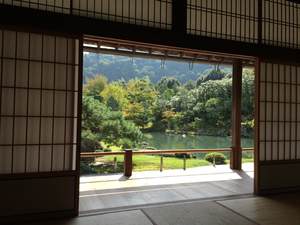Enjoy this letter? Get next Sunday's sent straight to your inbox.

 Ink and Feet
Ink and Feet


This week I made my way over to the Tenryū-ji Temple, nestled in the North-Western corner of the mountains that wrap around Kyoto. Tenryū-ji has been around in one form or another for well over a millennium, and in that time, it's helped to carve the history of Zen Buddhism, Kyoto, and Japan as a whole.
I sat down on a tatami mat in the second large room, and looked out on this staggering view (above) of the garden. A view - I'd later learn - that hasn't changed in the last 700 years. The garden sits, just as it was designed, by Musō Soseki in the 1300s.
Perhaps unsurprisingly, as I sat in the same spot as hundreds of brilliant and committed minds have sat over the centuries, and looked out on the same the view, I found something powerful about my mind, and life.
Sitting there, I saw that the garden offered a powerful and cohesive metaphor for my mind.
Like the wind rippling the surface of the water or the light shifting across the landscape from the moving clouds, my thoughts would come, dance, and then leave. I could even see them moving, and appreciate their beauty.
There were things like my heart beating, my lungs breathing, and feeling my toes that, like the koi swimming beneath the waters, I'd notice suddenly and be caught up by, and then forget - but that stayed and did their thing, regardless of my attention.
As I looked at this garden, I realized all the things that were out of its creators' control - typhoons, fires, droughts, plant diseases and insect infestations - not to mention ill-behaved tourists. There were far too many unknowns to control your way into a garden like this. Yet here it stood, unchanged, after almost a millennium.
Then the reason it had endured caught me. Nobody here worried about control.
They spent their time on cultivation.
Near the front entrance, four men stood on elegant curved ladders pruning - with their fingertips - each needle on each branch of a pine tree. From dawn until dusk, they worked - the entire day - on that same tree.
Everywhere I looked, I found this deep sense of cultivation - of paying attention and making each little part better every day. Of noticing and giving each plant what it needed. Of removing everything that didn't belong.
Paired with this attention was a letting go of the things that would come and go on their own - the wind, the rain, the lightning, and the tourists.
I wondered - what could my life and mind be like, if I applied this same sense of cultivation?
If every day, I spent a few intentional minutes shaping my thoughts or my environment, finding a way to create something as timeless and beautiful as this garden. Somewhere in which thoughts and feelings - both useful and unuseful could simply come, be appreciated, and go?
That idea stuck with me all day, and it's stuck with me since.
I've started to re-examine my daily routines - from my morning coffee to my evening unwinding. The way I interact with my mind and body, my emotions and thoughts.
I've asked, if my mind were a garden, how could I cultivate it? How about my body?
And I've started, little branches off in one small corner, to shape it into something beautiful.
Have a wonderful week.
-Steven
p.s. The best thing I saw this week was an unexpected, hidden delight. It turns out, when it rains in Boston, the streets are suddenly covered with poetry.
p.p.s. Just a quick reminder just in case you skimmed over the note at the top about next week's letter and the transition to the new system. Please keep an eye out, and click the confirm link when it comes! :) I'm so glad to have you with me.
Enjoy this letter? Get next Sunday's sent straight to your inbox.
